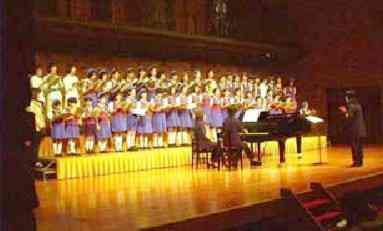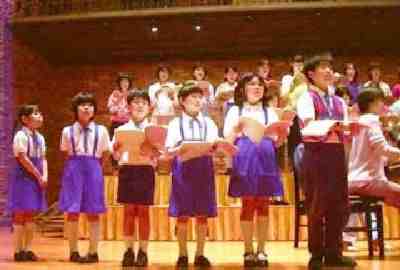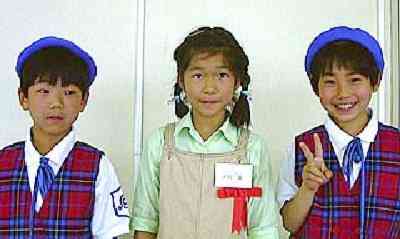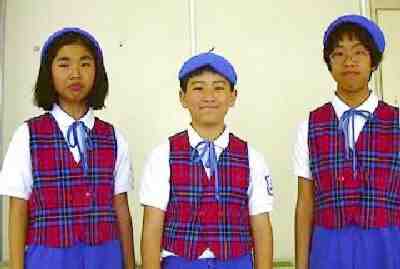
Figure 1.--Mixed choirs like the Little Singers of Takarazuka are mostlty girls. One of the coristers in the front page is a boy.

Figure 1.--Mixed choirs like the Little Singers of Takarazuka are mostlty girls. One of the coristers in the front page is a boy. |
Japan has many mixed choirs, in fact most Japanese choirs are at least nomially mixed.
In fact Japanese boys are often hesitant to participate in these mixed choirsd as they
in fact are largely composed of girls.
The Little Singers of Takarazuka is a community-based choir. It has no affiliation with any Takarazuka school nor the renouned Takarazuka theatre troop. The members of this chorus consist of children living in the city of Takarazuka or its outskirts and the choir
members go to several different area schools. Many girls go to different public schools and some to private schools. The girls come from both elementary and
secondary schools. The boys belonging to the choir are all elementry school boys.
"The Little Singers of TAKARAZUKA" is one example.
The choir was established in 1975, supported by Takarazuka Junior Chamber. The Choir is composed of approximately 50 members from 6 years old to 18 years,
who live in Takarazuka city or its outskirts.
The little singers usually practice three hours every Sunday morning. Thus the choir is
more of a part-time activity comared to the rigorous training program of the famed
Eropean choirs like the Vienna Choir Boys.
The Little Singers hold more than 20 concerts a year which are Annual concert in spring, Farewell concert for elder members, Christmas concert, Chorus festival and so on.
We had Three times concert tours for us after Korea in 1988, Taipei in 1993 and the
United States and Canada in 1998.
The Little Singers of TAKARAZUKA choristers are mostly girls, but there appear to also
be a few boys performing. The older members of the choir are girls. Most of the boys
participating are younger boys. They are all in elementry school boy. The oldest boy is a sixth grader, most are younger.
I'm not sure what the motivation of the boys is. Some may
just love to sing and decided on their own to pursue an interest in singing. Many may have been incouraged by their parents, probably their mothers. Japanese boys, especially elementary schools, are primarily supervised by their mothers and father is frequently
virtually absent. This chorus is only amateur, so it is impossible to be a big star.

Figure 2.--Mixed choirs like the Little Singers of Takarazuka are usually mostly girls. But a few mostly younger boys also participate. |
A typical peformance of this choir includes: 1. Sprituals, 2. Fukurou-Megane...Makiko Kinoshita, 3. Ayu no Uta...Akira Yuyama, and 4. Aoi-tikyuu to Kodomotachi...Hideo Kobayash.
Other concerts consisted of: Joyful songs...K,Hiroyuki Yamamoto, Nikki no Uta (Yasuo Minami)...K, Chikotan(Yasuo Minami)...K. Yet another program: Joyful songs...K,N,
Shikoku no Kodomouta(Akira Yuyama)...N, Gregorian chant(Saburou Takata)...K, and
Okashi no Uta(Yasuo Minami)...K.
The Little Singers of Takarazuka often perform with other choirs, such as the Itami city boys and girls choir and the Tatsuno city boys and girls choir.
The Little Singlers wear bright blue berets, white shirts, blue string ties, plaid vests,
blue suspender skirts or short pants, white knee socks, and black shoes. The uniform looks similar to an elementary school uniform in some ways. The boys and girls wear the same uniform,
except the boys wear shorts rather than skirts. Older boy may wear long pants. Some of the
boys wear short white socks, all of the girls wear white kneesocks. Boys also wore
white kneesocks, but some wore short socks. All of the choristers wear black shoes. Some of the girls wear strap shoes.
About the berets. The boys as well as the girls wear berets, although it is unusual for Japanese boys--except the smallest, to wear berets. Berets are very common in girls uniforms; so it isn't too surprising
that a largely girl's choir would wear berets. Actually some Japanese boy choirs also have berets. Cub and Boy Scouts also wear berets in the 1990s. With these exceptions, however,
virtually the only Japanese children wearing berets are girls.

Figure 3.--These are some of the third graders participating in the choir. Both boys and girls wore esentially the same uniform |
Graduation from KONAN university department of science. He studied under Ken-ichiro Kobayashi and Yoshio Saida how to conducts. He commanded many university
choruses. The regular conductor of the Little Singers of Takarazuka , the Voicefield Chorus, Konan University Glee Club, and the Kobe Port singers. In VEGA MESSIAH played every year in Takarazuka Vega hall,takes charge of chorus guidance under Tatsuji
Hayashi. Ashiya Chorus Society vice chairman,Hyogo Prefecture chorus director society member, meeting member of 10 Heisei directors, Chorus person group "music tree" member.
Graduation from a Mukogawa women's junior college education department.
In Takarazuka elementary school which it worked in first,It meets with the brightness of the eye of the children of "I want to sing more". A chorus part was organized. The thing becomes the origin of today's chorus activities. She has taught the Little singers of Takarazuka from 1982. A youth's prize of Hyogo Prefecture was earned. Meeting member of 10 Heisei directors. She is a tacher at the Takarazuka city MIZA elementary school.

Figure 4.--This 6th grade boy wears the blue beret of the choir, he doesn't seem to care for it much. Judging by the size of his vest, hw has been in the choir for several years. |
Takarazuka city is an old post town that has been well known by its hot spring and revue.
Recently, however, it is also popular as a town of music. Many international music competitions are held there. One of the most
famous competitions is Takarazuka international chamber chorus contest.
Takarazuka city is located near Osaka, the second largest city in Japan, or a port town of Kobe. It only takes 30 minutes from both of the cities. 200,000 people live in Takarazuka city.
Takarazuka is very well known in Japan. It has one of the most famous theatrical troupes in
Japan--all female. There audience is also 99 percent female, and the
women/girls who take the male roles achieve pop-star celebrity status,
occasioning swoons and screams among young girls whenever they appear in
public. Another example of the fascinating differences between Japan and the
West. This is a serious theatrical troupe, but some of the plays produced, like Japanese
comic books, would be considered highly inappropriate in many western countries.
The Little Singers of Takarazuka is not associated with the troupe.
Navigate the Historic Boys' Clothing Web Site:
[Introduction]
[Chronologies]
[Style Index]
[Biographies]
[Bibliographies]
[Contributions]
[Activities]
[Countries]
[Boys' Clothing Home]
Navigate the Historic Boys' Clothing Japnese pages:
[Main Japanese page]
[Japanese monarchy]
[Japanese school uniform]
[Japanese scouts]
[Japanese choir page]
[Japanese music recitals]
[Japanese department stores]
Navigate the Historic Boys' Clothing Web choir costume pages:
[Return to the Main Japanese choir page]
[Return to the Main choir page]
[Australia]
[Austria]
[Belgium]
[Bulgaria]
[Denmark]
[England]
[France]
[Finland]
[Germany]
[[Ireland]
[Netherlands]
[New Zealand]
[Poland]
[South Africa]
[United States]